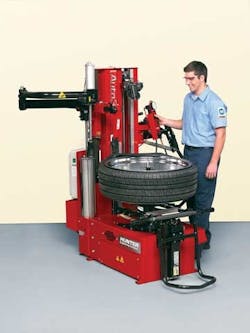Servicing the newest tires and wheels coming as OE is more challenging than ever for a number of reasons. “Generally, they are lower profile, larger diameter wheels that are heavier and more difficult to service than a similar vehicle model would have been just a few years ago,” says Pete Liebetreu, senior product manager at Hunter Engineering Co.
Unique fitments add another level of difficulty. “In addition, each OEM has a few special fitments that are major challenges for mounting or demounting, and often these are not rare or exotic models like in the past,” says Liebetreu. He cites a couple examples: “Toyota Sienna and RAV4 models have 17- and 18-inch run-flats that are as difficult as anything BMW will fit.”
Equipment suppliers are keeping pace with the challenge of servicing the latest tires and wheels. Here is a look at some of their latest offerings for mounting equipment.
BendPak Inc.
With newer wheels and tires getting larger and heavier and many featuring TPMS sensors, choosing the right tire changer is critical, says Jeff Kritzer, senior vice president of sales and marketing for BendPak Inc.
For shops working on standard passenger vehicles, a tire changer with a wheel clamping range up to 22 inches would be sufficient.
For fleet operations that service mostly passenger vehicles and light-duty truck tires and wheels, a standard swing-arm or tilt-back style changer with a wheel clamping range up to 24 inches should be adequate.
Having at least one tire changer with assist tools or helper arms is almost essential, according to Kritzer.
One of the most popular assist tools is a traveling drop-center tool that holds stubborn sidewalls in the drop-center area of the wheel when mounting. Lower bead lifting discs are also helpful tools that can be used to unseat stubborn lower beads or to elevate tires for proper tool placement.
Some machines also feature bead assist rollers near the mounting head that help position and maintain the top bead at an optimum position during both removal and installation of tough sidewall tires.
Hennessy Industries Inc.
“With not much new in the realm of new tire or wheel technology over the last few years, we have seen increased emphasis on productivity and usability... getting the job done right the first time and turning bays quickly. It has certainly impacted the way we think about and prioritize innovations in mounting and balancing equipment,” says Kevin Keefe, vice president of marketing for Hennessy Industries Inc.
In July, the company rolled out the Coats’ Grip Max Plus Clamps for the X-series and APX series tire changers. In addition to lasting 30% longer than conventional clamp covers, the updated design has a jaw profile that accommodates newer rim flange profiles. Improved materials and a wider grip contact area minimize slip on polished wheels, according to the company.
Hennessy added a leverless tire changer to its X-series line in 2012. The Coats 70XL eliminates the use of manual tire tools and helps improve productivity. An exclusive swing arm-locking mechanism greatly reduces the operator effort required for even the most challenging mount/demount applications, according to Hennessy. The company also introduced the Coats EL-X Express Lane Inflation System as an upgrade option for all Coats rim clamp tire changers. Designed to reduce bay times, the EL-X provides time savings of 20% or more on a four-tire ticket compared to the conventional inflation process.
[PAGEBREAK]
Hunter Engineering Co.
There is an increasing proliferation of leverless and press systems for all types and models of tire changers, according to Liebetreu. “One of the fastest growing tire changer types sold today are center chucking machines. These were virtually non-existent five years ago. Today they are the choice for many shops that want to completely eliminate the risk of rim damage that comes with tabletop tire changers.”
Liebetreu says one-press-arm tire changers are an absolute minimum, but most tire stores need to be considering a two-press-arm system for at least one tire changer in the shop. “There are just too many OEM fitments being produced today that require more control than a typical one-press-arm tire changer can deliver.” He advises dealers to buy equipment for their future needs, not their present needs.
Launch Tech USA Inc.
Launch Tech USA Inc. introduced a new line of tire changers and balancers for both the automotive and heavy-duty markets in July. The Ontario, Calif.-based company expanded its product line to four tire changers and three new balancers for the automotive industry. The company also entered the commercial market last month.
Launch Tech introduced two heavy-duty tire changers and one heavy-duty wheel balancer to service the semi-truck, bus and motor home markets as well as the agricultural market.
Ravaglioli SpA
Ravaglioli SpA brings five no-lever tire changing technologies to America through its RavAmerica division. RavAmerica President Nick McCullough says Ravaglioli offers a no-lever tire mounting system for every application and budget.
The automated G1500 allows the operator to input tire data and the software will select the proper program for the application. The operator can overrule the program selection but the software will not allow a program that is not appropriate for the tire type.
The machine demounts and mounts the tire with minimum assistance from the G1500’s operator. Once data has been input for a tire, that tire’s data can be recalled at any time, according to the company.
The Rav Magic tire changer is a more simplified version of the no-contact, leverless type machine. “Movements are carried out manually by pneumatic controls, therefore there is more operator interaction involved in the mounting and demounting process. The critical factors of all plastic and no metal-to-metal contact and center hub mounting are still present in this more cost-effective model,” says McCullough.
The company’s two Slivo models, available in tilt-back and swing-arm types, represent a “technical leap into the realm of clamping table-type machines,” says McCullough. “The innovative Slivo mounting tool allows the operator to mount in a true no-lever manner without the use of the steel lever or bar.”
For tubeless medium truck and light truck, the new GTB-16N model requires no lever to quickly change medium and light truck tires with little effort. A 22.5-inch standard tubeless tire can be demounted and mounted in 30 seconds, says McCullough. ■




